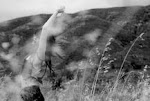 Photo: Horacio Coppola
Photo: Horacio Coppola
You've probably heard of
BorgesPerhaps you've read some of his works and liked what you read. Maybe you've been to Buenos Aires before, and while you were here, you were curious to learn more about the author. Maybe you sat at the cafés he frequented (Tortoni, La Biela, etc), visited the National Library he once directed, went to Plaza San Martin where he took long walks or walked through
Palermo, the neighborhood where he grew up. Maybe you did all of this without even knowing about Borges and how this all relates to him. To my surprise, I've had two or three clients very interested in Borges, his work and his life in Buenos Aires. It is thanks to one of these clients (a couple actually) that a few years ago, I had the pleasure of following the author's "footsteps" - this time consciously
* and in the company of someone from AD who actually knows a respectable bit about the author and his life, unlike me.
This year, in the frame of
Buenos Aires as Book Capital of the World, there have been many interesting events which I've been sharing with you. Today, it's about a new exhibition organized by the Ministry of Culture of the city of Buenos Aires.
“Cosmópolis, Borges y Buenos Aires” is an audiovisual exhibition, that explores the connection between the Argentinian writer and the city of Buenos Aires.
Created by Juan Insúa, “Cosmópolis" is an adaptation of the same exhibition that was presented at the Contemporary Cultural Center of Barcelona in 2002. This new version explores in a more profound manner this particular bond between Jorge Luis Borges and the city of Buenos Aires.
Through images and audiovisual material, “Cosmópolis, Borges y Buenos Aires” invites us to explore the evolution of Borges' literature with special attention to the way the author passes from a precise stage (Buenos Aires) to a universal city.
The exhibition is divided into seven sections that follow the work of the author in chronological order as well as a thematic manner:
-FUNDACIÓN MÍTICA (Mythic Foundation)
-FERVOR DE BUENOS AIRES (Passion of Buenos Aires)
-EL SUR METAFÍSICO (Metaphysic South)
-LA CIUDAD TRANSFIGURADA (Transfigured city)
-LA BIBLIOTECA INFINITA (Infinite library)
-EL HERESIARCA CANONIZADO
-COSMÓPOLIS
About 150 photos from photographers such as Horacio Coppola, Grete Stern, Humberto Rivas, Pepe Fernández y Facundo Zuviría help us situate ourselves in the city of Buenos Aires in different time periods, along with seven audiovisual pieces including “Fundación mítica de Buenos Aires” - corresponding to a poem that traces the poetic process of the foundation of Buenos Aires; “Fervor de Buenos Aires” which explores the Buenos Aires of the 1920's through moving images of that time period, allowing us to feel the city at the start of the century; and “El Tango” which elaborates a reflection on the origins and evolution of Tango, among others.
Where? Casa de la Cultura del Gobierno Porteño: Avenida de Mayo 575, Buenos Aires.
When? Tuesdays to Sundays from 14:00 to a 20:00hs. Til December 2011. *meaning that this time I was doing it in order to understand a little more about Borges and not by coincidence.




















